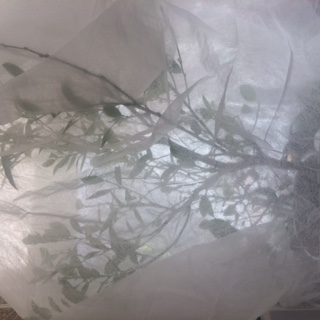
These are tough times for those plants that are waiting in the greenhouse for warmer days. They have made it through winter, yes, and it is true that light levels are improving all the time, but many are weakened by their months in less-than-perfect circumstances, and need a little extra help to limp through to spring. Such is the case with my step-father’s lemon trees, which I have been called in to examine and pass judgment upon. They were in rude health coming out of last summer after a good spell outdoors, and have spent the winter in a porch attached to the house. Citrus need to be indoors as they will be killed by a frost, but they are tolerant of pretty low temperatures, and a porch is about as perfect a situation as these plants will get in the circumstances – they have had the higher levels of light given by being in a mainly glass building, but there will also be a little heat coming from the house to keep temperatures well above freezing.
However these particular plants are looking terribly sorry for themselves, dropping leaves and covered in a grimy deposit. This is a clue, and we can follow it back to the source: sooty deposits are often formed when fungi move in to colonise honeydew lying on the leaves; honeydew lies upon the leaves because sap sucking insects are feeding on the leaves above and dropping the excess; and lo and behold when we traced back along the branches there were the lumpy, bumpy culprits: scale. Scale are very like aphids in modus operandi – they latch their mouth pieces into the plant’s sap and suck away. They get a hold when the plant is weakened – winter – and then weaken it further. They differ in appearance though as they cover themselves in an impenetrable waxy coating, and work away underneath. Mealybug are also frequent citrus pests and work in the same way, except they cover themselves with a fluffy, cotton wool like substance. Luckily removal of both is fairly simple, if painstaking. Take a cotton bud and dip it in methylated spirits then wipe it over the scale or mealybug. The methylated spirits will break down the waxy coating and allow you to wipe away the pest beneath.
Infestation dealt with it is a good time to give citrus trees a little attention anyway. There is no need to feed them just yet – start with a weak solution of a high nitrogen feed at the end of March, just as they are starting into growth – but you can increase water a little and perhaps remove any extra coverings of horticultural fleece that have been keeping them warm when nights are particularly cold. Keep an eye on the weather forecast and keep them nearby in case of cold nights, but the increased air flow and increased light levels can only help. This is also the time to do a little pruning if your plant needs it. Cut any lengthy growths back by two thirds to encourage branching, though the way to keep plants nicely bushy is to pinch out the tips as they grow during summer. Lots of plants will have flowers on them at this time and they need good humidity in order to be pollinated and produce citrus fruits this time next year. Either stand the plants on a tray filled with pebbles and water – which will create a humid atmosphere around them – or mist the flowers frequently with a mister. This time next year your citrus plants should be healthy, pest free, and covered in beautiful fruits.


